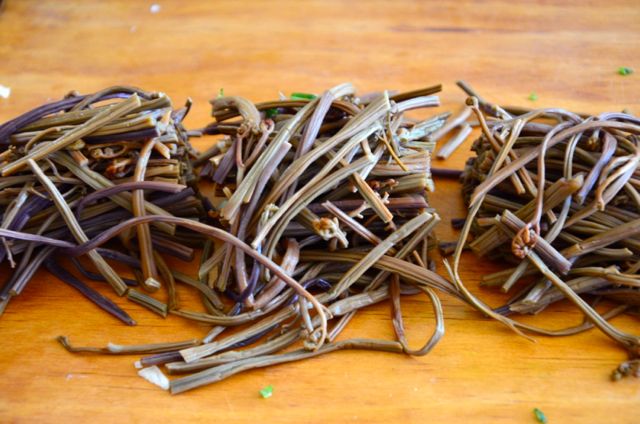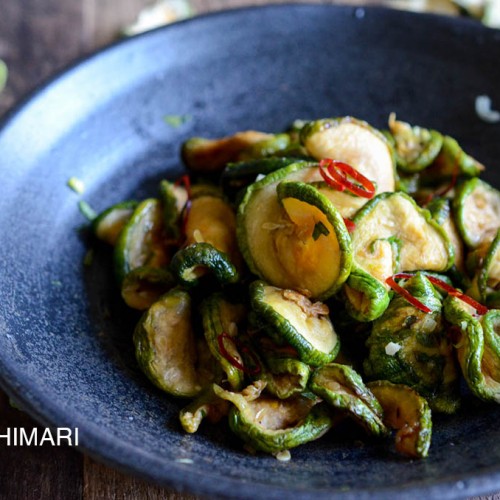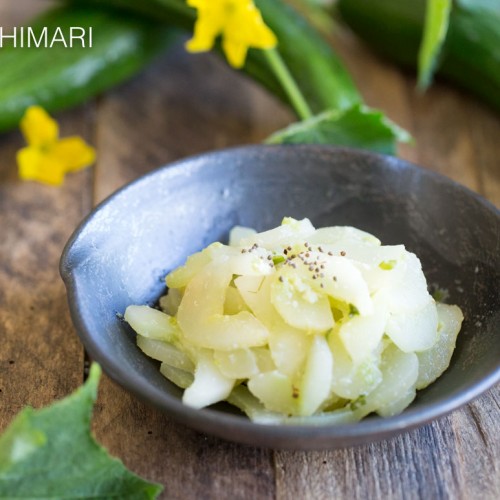Gosari or Bracken fiddleheads namul has a wonderful earthy flavor and chewy texture that all Koreans love (well most anyway..). It is the brown colored vegetable out of the 3 colored namuls.

Gosari (고사리)/Kosari or Bracken Fiddleheads namul is the last of the Korean three color vegetables (samsaek namul 삼색나물) dish that I have been blogging about.
What is Gosari or Bracken Fiddleheads?
Bracken belongs to a genus of large, coarse ferns in the family Dennstaedtiaceae. As ferns, brackens do not have seeds or fruits, but the immature fronds, known as fiddlehead greens, are eaten in different cultures. Bracken is one of the oldest ferns, with fossil records over 55 million years old having been found. In Korea, Gosari (고사리) comes usually in dried form and is eaten as a side dish or added to bibimbap, yukyejang or bindaetteok.
Is Bracken Poisonous?
It can be but please read more. Koreans have been eating Gosari for centuries but as I was researching about this fern, I found out that this Bracken fiddlehead is a very controversial vegetable. On the one hand, Bracken/Gosari has many health benefits because it is high in protein, vitamin b2 and fiber.
And according to traditional Korean medical books, it says that Gosari can be used to treat fever, insomnia and also can clear the mind. But on the other hand, there are studies that show it increased bladder cancers in farm animals who ingested Bracken fern raw.
There is also a study that say Bracken caused stomach cancer in laboratory mice due to a carcinogen in the plant. And there were even articles that mentioned there may be a link between the very high rate of stomach cancer in Koreans and Japanese and the Gosari being a popular vegetable in both Korean and Japanese diet.
But here are my conclusions:
- RAW vs COOKED – the carcinogen is water soluble and so if you cook it well in water and drain, lot of it will get washed out. The dried Gosari namul which is the kind that most Koreans eat, is first boiled and dried. And then you will see that Gosari is kind of cooked to death (haha) as it goes thru several steps of rehydration, blanching, etc. So the chances of any of the carcinogen being left is very very small.
- Link to stomach cancer – the latest studies show the most likely cause of Korean’s stomach cancer is due to bacterial infection (h pylori) and also due to the high salt diet.
- If anything, Koreans eat much less Gosari than 15 years ago and the number of stomach cancer has remained steady (between 1999 to 2009) while the number of colon cancer has almost doubled along with breast cancer which they attribute largely to a more westernized diet (which also can imply Koreans eat Gosari less often).
So, don’t worry too much but just cook Bracken properly and enjoy its wonderful flavor.
Is Bracken bad for men?
I love the earthy flavor and the chewy texture of Gosari but my husband refuses to eat it, so I never got to cook it as often as I would have liked. Why does he not eat it? Not because he doesn’t like the taste, not because he is allergic to it, not because of the carcinogen (as discussed above)…but because he, like many other Korean men, believe in the myth that it reduces their stamina..😝😝
I always wondered if there was any truth to that but never got around to researching about it. But you know.. yukyejang and bibimbap are just not the same without gosari but since he won’t eat them, I often ended up cooking without Gosari. So I was so happy that I chose to make gosari for this post because it was so yummy.. I forgot how good it was.
In case you are wondering where the myth came from – I researched a little bit on why one would say Gosari (Bracken Fiddlehead) is not good for men and there was nothing to support that. The closest explanation I could find why was that uncooked bracken contains the enzyme thiaminase, which breaks down thiamine (vitamin b1).
Which means eating excessive quantities of bracken can cause beriberi – a disease that can make one very weak. But in any case, this is not at all a concern if you are going to cook the bracken because the enzyme gets destroyed when you cook it.
Step-by-Step Directions
Servings: 4 Prep Time: 1 day Cooking time: 20 min Difficulty: easy
Ingredients
- Soak dried gosari in water for 24 hrs.
Dried Bracken Fiddlehead Gosari Rehydrating Gosari (Dried Bracken) in water Bracken has gotten nice and plump after soaking in water for a day.
Re-hydrated Gosari after soaking overnight in water - Mix 1 Tbs of water and 1 tsp of sweet rice flour and set aside.
- Drain gosari.
- Bring water to boil in a pot and blanch gosari in boiling water for couple minutes or until it is soft enough to your liking.
- Cool cooked gosari in cold water and drain.
rehydrated and boild bracken fiddleheads (gosari고사리) - This step is quite tedious but necessary to enjoy soft Gosari: sort through the stems and break off any bottom stem parts that are too fibrous and hard. The way to tell if it’s too hard is to try breaking if off. If it doesn’t easily break off then it’s probably too stringy to chew. It is similar to cutting off thick woody stems off of asparagus.
- Line up gosari (fiddleheads) and cut into 3 in (7.5 cm) lengths. In my case, it was cutting the length into thirds.
Cutting gosari for gosari namul - Put gosari in a bowl and season with soy sauce, sesame oil, garlic, green onions and sesame seeds. Mix it well with your hands so it is seasoned evenly.
- Heat a frying pan on medium heat, add 1 Tbs of vegetable oil and saute seasoned fiddleheads for 2 min.
Cooked bracken fiddleheads (gosari namul) - Pour 1/2 cup of water, cover and steam on medium heat for 5 min or until most of the water has evaporated. Uncover.
- Add sweet rice flour water to pan with fiddleheads. Saute for another 1-2 min until well mixed.
Now it’s done!
So don’t worry, just cook these three vegetables and enjoy them as a side dish or as part of bibimbap!

Three Color Vegetables (Samsaek Namul) - Brown Gosari
Ingredients
- 40 g dried bracken fiddlehead (gosari)
- 1 Tbsp guk ganjang (Korean soup soy sauce) (guk kanjang/kuk ganjang/gook kanjang or 1 tsp more)
- 1 Tbsp vegetable oil
- 1 Tbsp green onions, chopped
- 1 tsp garlic, chopped
- 1 tsp sesame seeds
- 1 tsp sesame oil
- 1/2 cup water
sweet rice flour slurry
- 1 Tbsp water
- 1 tsp sweet rice flour
Instructions
- Soak dried gosari in water for 24 hrs. It should be nice and plump after soaking in water for a day.
- Mix 1 Tbs of water and 1 tsp of sweet rice flour and set aside.
- Drain gosari.
- Bring water to a boil in a pot and blanch the gosari in boiling water for a couple minutes or until it is soft enough to your liking.
- Cool the cooked gosari in cold water and drain.
- This step is quite tedious but necessary to enjoy soft gosari: sort through gosari stems and break off any bottom stem parts that are too fibrous and hard. The way to tell if it’s too hard is to try breaking if off. If it doesn’t easily break off then it’s probably too stringy to chew. It is similar to cutting off thick woody stems off of asparagus.
- Line up gosari (fiddleheads) and cut into 3 in (7.5 cm) lengths. In my case, it was cutting the length into thirds.
- Put gosari in a bowl and season with soy sauce, sesame oil, garlic, green onions, and sesame seeds. Mix the ingredients well with your hands so the gosari is seasoned evenly.
- Heat a frying pan on medium heat, add 1 Tbs of vegetable oil, and saute seasoned fiddleheads for 2 min.
- Pour 1/2 cup of water, cover and steam on medium heat for 5 min or until most of the water has evaporated. Uncover.
- Add sweet rice flour water to pan with fiddleheads. Saute for another 1-2 min until well mixed.
- Serve as a side dish or as part of bibimbap.
Tips & Notes:
- You can freeze soaked and cooked gosari and use later to make namul.




























I never liked 고사리 growing up but I’ve noticed that I like so many things I used to avoid as a child. Thank you for this easy to follow recipe! Just a quick question- I’ve never seen mixing sweet rice flour water into 나물 before. What is the purpose of this? Is it just with 고사리 or do you do this with other 나물 too?
I know me too.. I actually didn’t like bibimbap growing up because I had a hard time chewing everything but now I love it. Mixing the sweet rice flour water is usually done only for Gosari and it’s certainly optional. I used to actually make it without the paste but found the paste adds another dimension of richer and smoother flavor so I added it in. There’s no special purpose per say other than just making it taste better. Imagine a sauce that’s made with or without the roux.
Why is this article titled: Three color vegetables?
Hi! It’s because it is one of a 3 part series post. There is green, brown and white (3 color) but since having them all on one post was too much, I decided to split them up into 3. Thanks for asking.
I had never heard of drying fiddleheads, such a good idea! Do you know if there is a Korean tradition for fermenting fiddleheads? An idea I had a while back, but have yet to try. Thank you for such informative posts!
Yes! It has a much deeper earthy taste when dried. Traditionally fiddleheads are not fermented but I did find one recipe where they make kimchi with the rehydrated fiddlhead. Recipe is pretty similar to making regular kimchi except it does not use any fish sauce. Hopefully this helps! Thanks for the comment.